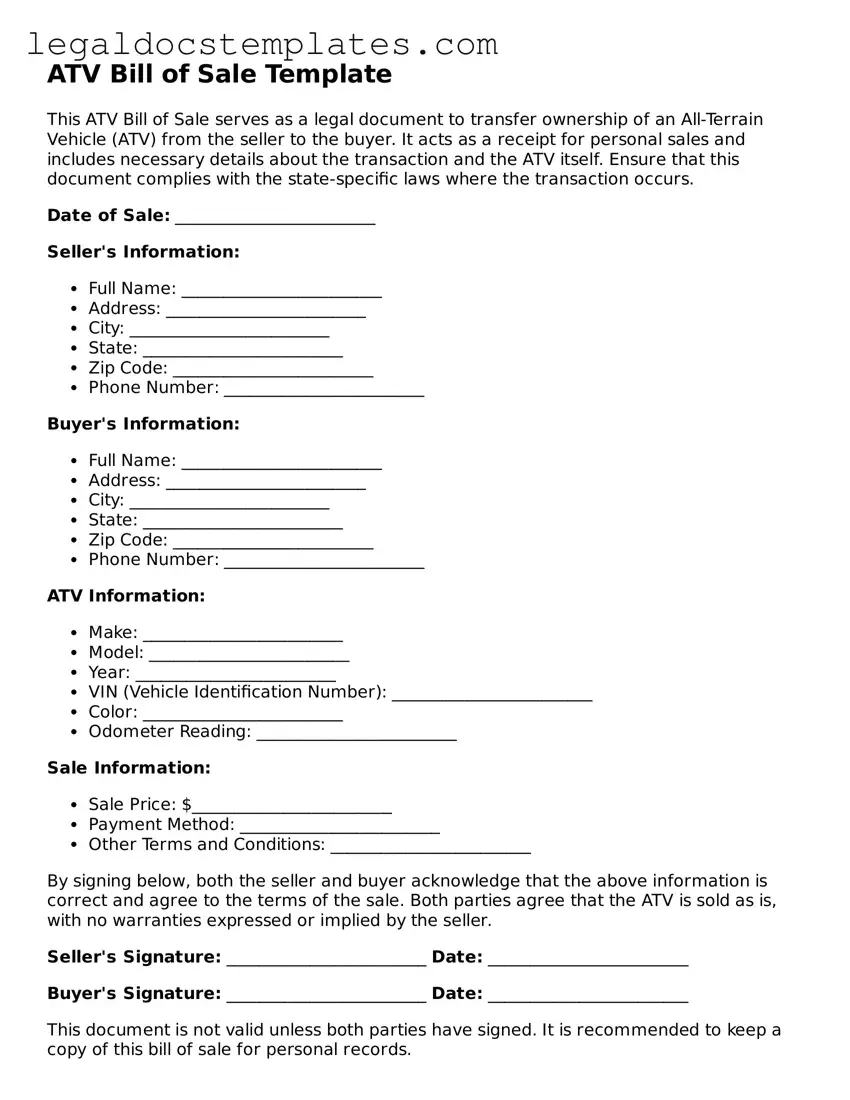The ATV Bill of Sale form shares similarities with the Vehicle Bill of Sale document, primarily as it serves to record the transaction of an all-terrain vehicle (ATV) from a seller to a buyer. This document provides legal proof of the transfer of ownership and includes details such as the price, description of the ATV, and information about both parties involved in the transaction. Like its counterpart for other vehicles, it can be required for registration processes and tax purposes, ensuring the documentation of the sale adheres to legal standards.
Another document akin to the ATV Bill of Sale is the Boat Bill of Sale. Both documents function as transactional records for different types of vehicles - one for land and the other for water. They include critical details like the make, model, year, price, and identification numbers of the vehicle, alongside the personal information of the buyer and seller. The Boat Bill of Sale, much like the ATV version, is essential for the registration of the boat and may be required for insurance purposes.
The Equipment Bill of Sale form is also similar, used when tools or machinery change ownership. While the primary focus is different — equipment rather than recreational vehicles — the purpose and structure of the document remain consistent. It lists the item's specifics, sale price, and party information, establishing a legal record of the transaction. This document is crucial in clarifying ownership, which can affect tax liabilities and business asset documentation.
Similar to the ATV Bill of Sale is the Motorcycle Bill of Sale, designed for the sale and purchase of motorcycles. It outlines the transaction details, including the VIN, make, model, year, and sale price, alongside buyer and seller signatures. This form is vital for the titling and registration of the motorcycle, underscoring the importance of formalizing the exchange in a manner recognized by law.
The Pet Bill of Sale is a document that, while it deals with living animals instead of inanimate vehicles, operates under the same premise. It documents the sale of pets, specifying the animal's breed, age, health information, and price. It provides a legal outline of the transaction, ensuring both buyer and seller understand their rights and responsibilities. This document is key in transactions where pedigree or certain rights over the animal are significant.
Likewise, the Firearm Bill of Sale is another document whose purpose resonates with that of the ATV Bill of Sale, though it concerns the transfer of ownership of guns. This form includes detailed descriptions of the firearm, the personal information of both transacting parties, and often, a certification of the legality of the transaction. Due to the nature of the item being sold, this document also plays a crucial part in meeting compliance with state and federal regulations.
Aircraft Bill of Sale documents, too, share similarities with the ATV Bill of Sale, in that they both serve to legitimize the sale of a mode of transportation. The Aircraft Bill of Sale includes detailed information about the aircraft, such as the make, model, serial number, and registration number, along with the sale price and details about the buyer and seller. For aircraft, this document is critical for the Federal Aviation Administration’s registration process.
The Furniture Bill of Sale is another document that functions like the ATV Bill of Sale but is used for the purchase and sale of furniture. Though the items in question differ greatly in terms of use and value, the underlying purpose of the document is to provide a record of the transaction, including a description of the furniture, the sale price, and the parties involved. This proves ownership and is useful for insurance or warranty claims.
Similar in purpose to the ATV Bill of Sale is the Business Bill of Sale, which is used to document the sale of an entire business or a portion of its assets. It includes comprehensive details about the business being sold, terms of the sale, and information on the buyer and seller. This document is crucial for the continuity of business operations, with implications for tax, licensing, and legal recognition of the new ownership.
Lastly, the General Bill of Sale form resonates with the purpose of the ATV Bill of Sale, acting as a more versatile document for documenting the sale of personal property of any kind. This includes everything from electronics to jewelry, outlining the item(s), the sale amount, and who the transaction is between. It is a useful document for legally recording any sale where a more specific form is not required, ensuring both parties acknowledge the transfer of ownership and terms of the sale.
